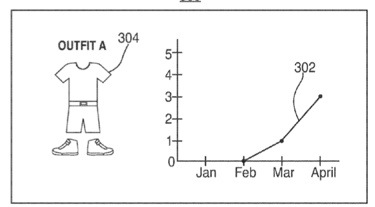Pretty soon you may be able to dress yourself online in a Virtual Closet if Apple has its way. The company has filed two patents at the US Patent & Trademark Office for such a venture.
Patent number 20100191770 is for a system and methods for providing a Virtual Fashion closet. Fashion items can be added to the Virtual Closet. Outfits may then be created by combining two or more of the fashion items. In some embodiments, the Virtual Closet system can create recommended outfits based on weather, season, or the user’s calendar.
The Virtual Closet system can allow a vendor to send recommended fashion items that may complete an outfit to a user for potential purchasing. In some embodiments, a social networking Virtual Closet can be provided. The social networking Virtual Closet can allow friends to see each other’s Virtual Closets, recommend outfits to one another, recommend fashion items to buy, recommend fashion items to get rid of, recommend outfits to wear at a particular event, share and borrow each other’s fashion items, or can otherwise suitably provide a social networking environment through the Virtual Closet. The inventors are Christine Kim Cho, Monica Tran and Stanley Carl Ng.
Here’s Apple’s background and summary of the invention: “Everyday, people have various articles of clothing, jewelry, purses, and other accessories that they wear and carry. These items can be stored at home in closets, drawers, shelves, or in other storage facilities. However, at times it may be difficult for a person to keep track of their clothing or easily view what items they own. For example, articles of clothing in a closet may be crowded together in a way that makes it difficult to view them, or the clothing may be stored in drawers or otherwise hidden from sight. As another example, a person may lend their clothing or other items to friends, and then forget who has borrowed these belongings. This may make it difficult for a person to organize or keep track of their clothing and other belongings.
“Systems and methods for providing a virtual fashion closet are described herein. The Virtual Closet may, for example, be provided through an application that is available on an electronic device. The electronic device can include any suitable device such as, for example, a laptop computer, a desktop computer, a digital media player, a personal e-mail device, a personal data assistant (‘PDA’), a cellular telephone, a handheld gaming device, a digital camera, or any other suitable electronic device.
“The Virtual Closet can include a catalogue or virtual representation of an actual, physical closet of a user. For example, the Virtual Closet may include images, descriptions, or both of ‘fashion items’ owned by the user. As used herein, the term ‘fashion item’ refers to any article of clothing, accessory, or other suitable item that a person may wear or carry.
“In some embodiments, outfits can be created by combining two or more fashion items of a Virtual Closet. For example, an owner of a Virtual Closet can create outfits from the fashion items in the Virtual Closet. As another example, outfits can be created that include fashion items that are not in the Virtual Closet. As one illustration, fashion items that are offered for sale by a third party (e.g., a store or vendor) can be used to build outfits, thus allowing a user to ‘try out’ fashion items prior to buying that fashion item. In some embodiments, a vendor can recommend the user buy a fashion items in order to complete a particular outfit.
“In some embodiments, the Virtual Closet can recommend outfits to be worn. For example, the Virtual Closet can recommend outfits based on the weather, based on the day or season, based on events that are scheduled in the user’s calendar, or based on any other suitable event. In some embodiments, the Virtual Closet can maintain a history of the fashion items that are worn by a user. The Virtual Closet can identify which fashion items are dirty (e.g., in the laundry) and therefore may be unavailable for wearing.
“In some embodiments, a social networking Virtual Closet can be provided. The social networking Virtual Closet can allow friends to see each other’s Virtual Closets, recommend outfits to one another, recommend fashion items to buy, recommend fashion items to get rid of, recommend outfits to wear at a particular event, share and borrow each other’s fashion items, or can otherwise suitably provide a social networking environment through the Virtual Closet.”
Patent number 20100191578, by the same inventors, involves systems and methods for providing enhanced access to high fashion using a portable electronic device. In some embodiments, an integrated application available on an electronic device can provide information for promotional and invitation-only events, allow a user to browse and search through fashion items, recommend fashion items to purchase based on outfits desired by the user, check for the availability of particular fashion items, and view or providing ratings or reviews for stores or fashion items.
Here’s Apple’s background of the invention: “Many buyers of high fashion desire to educate themselves prior to purchasing fashion items. In particular, buyers can wish to review what different merchants offer, compare the offered merchandise with what buyers already own, and review the latest trends. In addition, some buyers can wish to identify sales and availability of merchandise before going to a store to shop. To do so, buyers may need to purchase and read several fashion magazines, call or visit different stores to ascertain the availability of different items, and perform research using different sources (e.g., the Internet or other sources).
“While all of the resources a buyer may need to most effectively shop may be available, the resources may not be centralized or easily accessed from a single location. In addition, some resources may not be available over the same types of communications links. For example, some resources may only be available over the telephone, such as information regarding the specific availability of merchandise in particular stores. As another example, some information may only be available from a combination of resources (e.g., a buyer may be required to access different sources associated with different sellers). From a user’s perspective, this lack of centralization of interactions with the fashion provider can require more effort from the user wishing to take advantage of shopping resources than they wish to give, and perhaps even dissuade the user from shopping with the fashion provider (thus at a cost to the fashion provider).”



